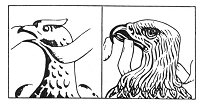The phœnix (which is the mythological Persian roc) is also the name of a Southern constellation, and therefore it has both an astronomical and an astrological significance. In all probability, the phœnix was the swan of the Greeks, the eagle of the Romans, and the peacock of the Far East. To the ancient mystics the phœnix was a most appropriate symbol of the immortality of the human soul, for just as the phœnix was reborn out of its own dead self seven times seven, so again and again the spiritual nature of man rises triumphant from his dead physical body.
Mediæval Hermetists regarded the phœnix as a symbol of the accomplishment of alchemical transmutation, a process equivalent to human regeneration. The name phœnix was also given to one of the secret alchemical formula. The familiar pelican of the Rose Croix degree, feeding its young from its own breast, is in reality a phœnix, a fact which can be confirmed by an examination of the head of the bird. The ungainly lower part of the pelican’s beak is entirely missing, the head of the phœnix being far more like that of an eagle than of a pelican. In the Mysteries it was customary to refer to initiates as phœnixes or men who had been born again, for just as physical birth gives man consciousness in the physical world, so the neophyte, after nine degrees in the womb of the Mysteries, was born into a consciousness of the Spiritual world. This is the mystery of initiation to which Christ referred when he said, “Except a man be born again, he cannot see the kingdom of God” (John iii. 3). The phœnix is a fitting symbol of this spiritual truth.
European mysticism was not dead at the time the United States of America was founded. The hand of the Mysteries controlled in the establishment of the new government, for the signature of the Mysteries may still be seen on the Great Seal of the United States of America. Careful analysis of the seal discloses a mass of occult and Masonic symbols, chief among them the so-called American eagle–a bird which Benjamin Franklin declared unworthy to be chosen as the emblem of a great, powerful, and progressive people. Here again only the student of symbolism can see through the subterfuge and realize that the American eagle upon the Great Seal is but a conventionalized phœnix, a fact plainly discernible from an examination of the original seal. In his sketch of The History of the Seal of the United States, Gaillard Hunt unwittingly brings forward much material to substantiate the belief that the original seal carried the Phœnix bird on its obverse surface and the Great Pyramid of Gizeh upon its reverse surface. In a colored sketch submitted as a design for the Great Seal by William Barton in 1782, an actual phœnix appears sitting upon a nest of flames. This itself demonstrates a tendency towards the use of this emblematic bird.
PHŒNIX OR EAGLE, WHICH? On the left is the bird’s head from the first Great Seal of the United States (1782) and on the right the Great Seal of 1902. When the first great Seal was actually cut, the bird represented upon it was very different from the eagle which now appears; the neck was much longer and the tuft of feathers, at the upper back part of the head was quite noticeable; the beak bore little resemblance to that of the eagle; and the entire bird was much thinner and its wings shorter. It requires very little imagination to trace in this first so-called eagle the mythological Phœnix of antiquity. What is more, there is every reason why a phœnix bird should be used to represent a new country rising out of an old, while as Benjamin Franklin caustically noted, the eagle was not a bird of good moral character!
AN EGYPTIAN PHŒNIX.
From Wilkinson’s Manners and Customs of the Ancient Egyptians. The Egyptians occasionally represented the Phœnix as having the body of a man and the wings of a bird. This biform, creature had a tuft of feathers upon its head and its arms were upraised in an attitude of prayer. As the phœnix was the symbol of regeneration, the tuft of feathers on the back of its head might well symbolize the activity of the Pineal gland, or third eye, the occult function of which was apparently well understood by the ancient priestcraft.
THE OBVERSE AND REVERSE OF THE GREAT SEAL OF THE UNITED STATES OF AMERICA.
From Hunt’s History of the Seal of the United States. The significance of the mystical number 13, which frequently appears upon the Great Seal of the United States, is not limited to the number of the original colonies. The sacred emblem of the ancient initiates, here composed of 13 stars,, also appears above the head of the “eagle.” The motto, E Pluribus Unum, contains 13 letters, as does also the inscription, Annuit Cœptis. The “eagle” clutches in its right talon a branch bearing 13 leaves and 13 berries and in its left a sheaf of 13 arrows. The face of the pyramid, exclusive of the panel containing the date, consists of 72 stones arranged in 13 rows.

Moe is the founder of GnosticWarrior.com. He is a father, husband, author, martial arts black belt, and an expert in Gnosticism, the occult, and esotericism.











![How the Isle of Wight received Christian inhabitants, and two royal youths of that island were killed immediately after Baptism [686 A. D.] | Book 4 | Chapter 16 How the Isle of Wight received Christian inhabitants, and two royal youths of that island were killed immediately after Baptism [686 A. D.] | Book 4 | Chapter 16](https://www.gnosticwarrior.com/wp-content/plugins/contextual-related-posts/default.png)